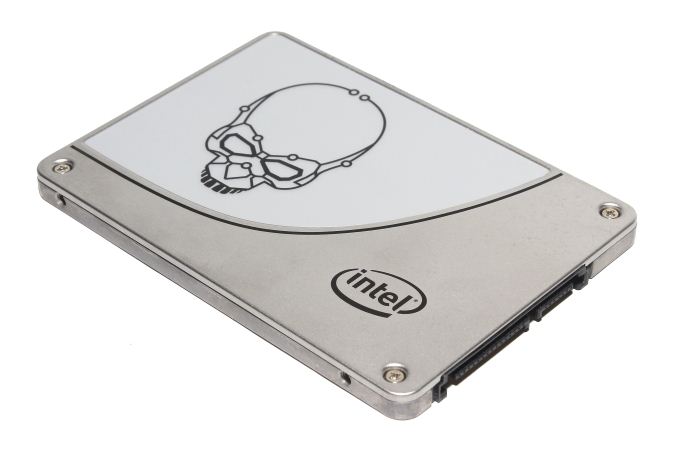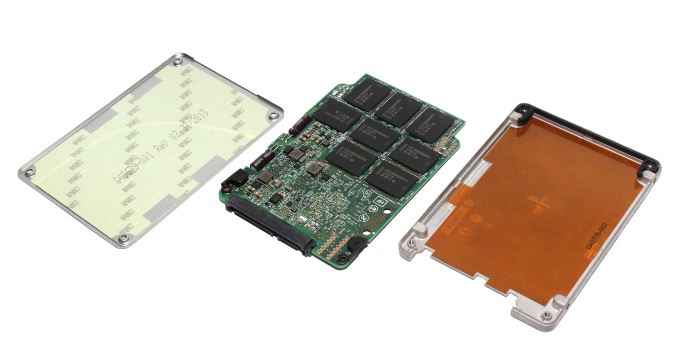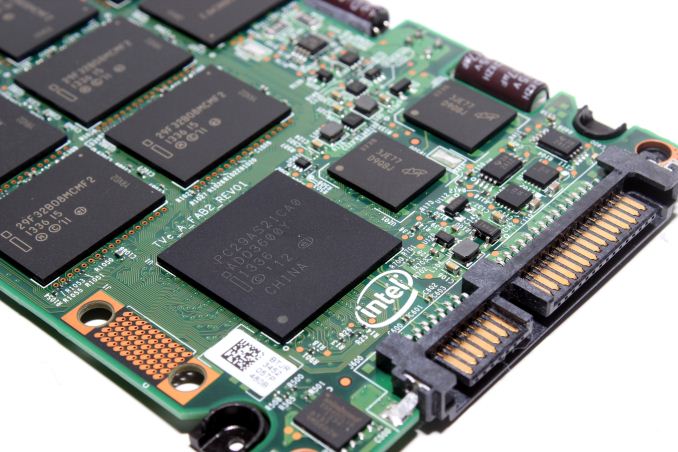Intel SSD 730 (480GB) Review: Bringing Enterprise to the Consumers
by Kristian Vättö on February 27, 2014 12:00 PM EST- Posted in
- Storage
- SSDs
- Intel
- Intel SSD 730

The days of Intel being the dominant player in the client SSD business are long gone. A few years ago Intel shifted its focus from the client SSDs to the more profitable and hence alluring enterprise market. As a result of the move to SandForce silicon, Intel's client SSD lineup became more generic and lost the Intel vibe of the X-25M series. While Intel still did its own thorough validation to ensure the same quality as with its fully in-house designed drives, the second generation SandForce platform didn't allow much OEM customization, which is why the SSD 520 and other SandForce based Intel SSDs turned out to be very similar to the dozens of other SandForce driven SSDs in the market.
The SSD market has matured since the X-25M days and a part of the maturing process involves giving up profits. Back in 2007-2008 the SSD market (both client and enterprise) was a niche with low volume and high profits, so it made sense for Intel to invest in custom client-oriented silicon. There wasn't much competition and given Intel's resources and know-how, they were able to build a drive that was significantly better than the other offerings.
The high profits, however, attracted many other manufacturers as well and in the next few years Intel faced a situation it didn't like: profit margins were going down, yet bigger and bigger investments had to be made in order to stay competitive in the client market. OCZ in particular was heavily undercutting Intel's pricing and big companies with technological and scale advantage like Intel tend not to like the bargain game because at the end of the day it's not as profitable for them. The enterprise market is a bit different in this regard because price is not usually the commanding factor; instead the focus is on reliability, features and performance, which made it an easy choice for Intel to concentrate its resources on covering that market instead.
For the majority of consumers this change in focus was negligible since the likes of Micron and Samsung had started paying attention to the retail consumer SSD market and Intel was no longer the only good option available. However, enthusiasts were left yearning for an Intel SATA 6Gbps design as many had built brand loyalty for Intel with the X-25M. In late 2012 the wishes materialized but to their disappointment only in the form of an enterprise SSD: the DC S3700. This verified that enterprise was Intel's first priority but given that it was a SATA 6Gbps rather than a PCIe design, it left hope for a more client-orientated in-house Intel solution. Fast-forward to today and that solution is now here. Please meet the SSD 730, Intel's new client flagship.
Adopting the platform from the DC S3500/S3700, the SSD 730 is Intel's first fully in-house designed client drive since the SSD 320. The SSD 730 is not just a rebranded enterprise drive, though, as both the controller and NAND interface are running at higher frequencies for increased peak performance. While the branding suggests that this is an enterprise drive like the SSD 710, Intel is marketing the SSD 730 directly to consumers and the DC S3xxx along with the 900 series remain as Intel's enterprise lineups. And in a nod to enthusiasts, the SSD 730 adopts the Skulltrail logo to further emphasize that we are dealing with some serious hardware here.
| Capacity | 240GB | 480GB |
| Controller | Intel 3rd Generation (SATA 6Gbps) | |
| NAND | Intel 20nm MLC | |
| Sequential Read | 550MB/s | 550MB/s |
| Sequential Write | 270MB/s | 470MB/s |
| 4K Random Read | 86K IOPS | 89K IOPS |
| 4K Random Write | 56K IOPS | 74K IO |
| Power (idle/load) | 1.5W / 3.8W | 1.5W / 5.5W |
| Endurance | 50GB/day (91TB total) | 70GB/day (128TB total) |
| Warranty | Five years | |
| Availability | Pre-orders February 27th - Shipping March 18th | |
Intel is serious about the SSD 730 being an enterprise-class drive for the client market as even the NAND is pulled from the same batch as Intel's MLC-HET NAND used in the S3700 and the endurance rating is based on JEDEC's enterprise workload. JEDEC's SSD spec, however, requires that client SSDs must have a data retention time of one year minimum whereas enterprise drives must be rated at only three months, which gives the S3500/S3700 a higher endurance. MLC-HET also trades performance for endurance by using lower programming voltages, resulting in less stress on the silicon oxide.
| Intel SSD 730 | Intel SSD 530 | Intel SSD DC S3500 | Intel SSD DC S3700 | |
| Capacities (GB) | 240, 480 | 80, 120, 180, 240, 360, 480 | 80, 120, 160, 240, 300, 400, 480, 600, 800 | 100, 200, 400, 800 |
| NAND | 20nm MLC | 20nm MLC | 20nm MLC | 25nm MLC-HET |
| Max Sequential Performance (Reads/Writes) | 550 / 470 MBps | 540 / 490 MBps | 500 / 450 MBps | 500 / 460 MBps |
| Max Random Performance (Reads/Writes) | 89K / 75K IOPS | 48K / 80K IOPS | 75K / 11.5K IOPS | 76K / 36K IOPS |
| Endurance (TBW) |
91TB (240GB) 128TB (480GB) |
36.5TB |
140TB (200GB) 275TB (480GB) |
3.65PB (200GB) 7.3PB (400GB) |
| Encryption | - | AES-256 | AES-256 | AES-256 |
| Power-loss Protection | Yes | No | Yes | Yes |
Continuing with the enterprise features, there is full power-loss protection similar to what's in the S3500/S3700. I'm surprised that we've seen so few client SSDs with power-loss protection. Given the recent studies of power-loss bricking SSDs, power-loss protection should make a good feature at least in the high-end SSDs.
Test System
| CPU |
Intel Core i5-2500K running at 3.3GHz (Turbo and EIST enabled) |
| Motherboard | AsRock Z68 Pro3 |
| Chipset | Intel Z68 |
| Chipset Drivers | Intel 9.1.1.1015 + Intel RST 10.2 |
| Memory | G.Skill RipjawsX DDR3-1600 4 x 8GB (9-9-9-24) |
| Video Card |
Palit GeForce GTX 770 JetStream 2GB GDDR5 (1150MHz core clock; 3505MHz GDDR5 effective) |
| Video Drivers | NVIDIA GeForce 332.21 WHQL |
| Desktop Resolution | 1920 x 1080 |
| OS | Windows 7 x64 |
Thanks to G.Skill for the RipjawsX 32GB DDR3 DRAM kit












96 Comments
View All Comments
Neo Zuko - Monday, March 3, 2014 - link
Or more exactly, why is the SanDisk Extreme II better than the Samsung 840 Pro for Anandtech?coder111 - Tuesday, March 4, 2014 - link
Regarding hardware encryption- don't use it. Seriously, these days, can you really trust anything but open-source encryption not to have backdoors for NSA, FBI, GCHQ or any other intelligence, police or RIAA/MPAA agencies out there?I do understand hardware encryption is faster, easier, more transparent. But there is no way to prove it's correct. And if it can be bypassed by government, it's useless.
psyq321 - Monday, March 10, 2014 - link
How can you trust anything that you didn't write from the zero (including compiler >and< hardware)? Who is to attest that your compiler or compiler used to compile your favorite distro/software is not injecting backdoors? Who is to attest that your hardware does not have a firmware-level exploit that can be used to log keys?Can you trust software with millions of lines of code that you did not write?
Nope, you can't. Even open source software has a history of lingering vulnerabilities that stuck for >ages< (Debian pseudo "random" number generator, for example).
If you think your communication is going to be targeted by any government, the best idea is to be as paranoid as it gets and use multiple measures perhaps including >both< hw. level and software encryption.
If you are, like majority of businesses, mostly concerned whether your disk might fall into wrong (criminal) hands, then disk-level hardware encryption would probably be not worse than software encryption.
amddude10 - Friday, November 28, 2014 - link
It could be helpful to avoid the wrong information getting into the hands of a competitor or something like thatHrel - Wednesday, March 5, 2014 - link
Those Seagate drives are looking better every day. I just saw a 240GB one on Newegg for $120!!!!preamp - Tuesday, March 11, 2014 - link
Ouch! "(...) the chassis also gets very hot and uncomfortable to touch under load" should translate something like 50°C on the outside of the SSD, which means that the electrolytics will constantly be cooked.Granted, the Chemi-Con KZH are rather good ones (although not the most reliable out there) with a rating of 5000 hours at 105°C, but I've had rather bad experiences with any electrolytics running hot in unvented cases for extended periods of time.
According to the Illinois Lifetime Calculator those caps should last for more than 20 years at 60°C and 12V, but personally I have my doubts that the power loss "protection" is still working up to spec while approaching end of warranty...
crazzeto - Tuesday, March 11, 2014 - link
Funny, I actually just bought a Crucial M500 (240GB) for my ~6yr old HP DV6500 Media Laptop. I guess I was a little surprised to see generally this isn't even the fastest ssd lol. It's been a number of years since I've been a serious home builder, so I'm not fully in touch.Anyway I'm blown away by what a difference it makes even in this ancient machine running Vista 64B with just 2GB ram.
binarycrusader - Tuesday, June 17, 2014 - link
NewEgg as of today (for the next 24 hours or so?) is running a special on this drive, $379.99 for the 480GB model, which makes it a lot more appealing.KAlmquist - Saturday, November 22, 2014 - link
And today the price is $110 for the 240GB drive and $200 for the 480GB drive. The latter price is actually ten dollars less than the 512GB Crucial MX100. So Intel seems to be serious about selling these drives in quantity.amddude10 - Friday, November 28, 2014 - link
Yes, and similar sale prices in Canada as well. They still show the original MSRP in sales to try to make it seem like a better deal, but the actual MSRP seems to have come down significantly as well.As far as I know, the 730 is the only drive with full power loss protection in the consumer segment, which, along with Intel's awesome drive monitoring functionality, makes this the most attractive SSD in my mind. It makes me wonder... what's the catch? I really don't care about the lower speed (especially on the 240gb model).